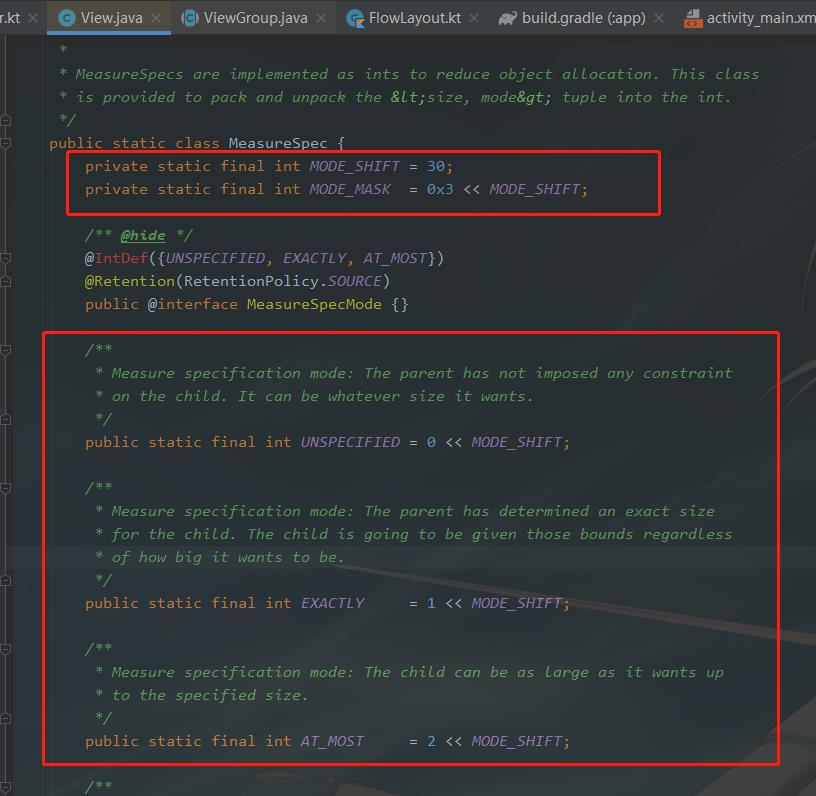Android View的测量参数
Posted 进击的包籽
tags:
篇首语:本文由小常识网(cha138.com)小编为大家整理,主要介绍了Android View的测量参数相关的知识,希望对你有一定的参考价值。
文章目录
- android 的View是一个树结构,而View的大小,ViewGroup的大小,会相互影响,其中有两个重要参数
1.LayoutParams布局参数
1.了解LayoutParams
- LayoutParams就是布局参数,子View通过LayoutParams告诉父容器(ViewGroup)应该如何放置自己。
- 每个ViewGroup的子类都有自己对应的LayoutParams类,典型的如LinearLayout.LayoutParams和
FrameLayout.LayoutParams等,可以看出来LayoutParams都是对应ViewGroup子类的内部类。 - MarginLayoutParams是和外间距有关的。和LayoutParams相比,MarginLayoutParams只是增加了对上下左右外间距的支持。实际上大部分LayoutParams的实现类都是继承自MarginLayoutParams,因为基本所有的父容器都是支持子View设置外间距的。

2.优先级问题
- 属性优先级问题 MarginLayoutParams主要就是增加了上下左右4种外间距。在构造方法中,先是获取了margin属性;如果该值不合法,就获取horizontalMargin;如果该值不合法,再去获取leftMargin和rightMargin属性(verticalMargin、topMargin和bottomMargin同理)。我们可以据此总结出这几种属性的优先级
- 优先级 Margin > HorizontalMargin和VerticalMargin > LeftMargin和RightMargin、TopMargin和BottomMargin
3.LayoutParams参数
- 在XML中定义View
在Java代码中直接生成View对应的实例对象 - 3.1.如果xml布局里面是具体的dp,那么layoutParams的值就是大于0。
- 3.2.如果是MATCH_PARENT
public static final int MATCH_PARENT = -1; - 3.3.如果是WRAP_CONTENT
public static final int WRAP_CONTENT = -2;

4.addView
/**
* 重载方法1:添加一个子View
* 如果这个子View还没有LayoutParams,就为子View设置当前ViewGroup默认的LayoutParams
*
* @param child
*/
@Override
public void addView(View child)
addView(child, -1);
/**
* 重载方法2:在指定位置添加一个子View
* 如果这个子View还没有LayoutParams,就为子View设置当前ViewGroup默认的LayoutParams
*
* @param child
* @param index View将在ViewGroup中被添加的位置(-1代表添加到末尾)
*/
@Override
public void addView(View child, int index)
if (child == null)
throw new IllegalArgumentException("Cannot add a null child view to a ViewGroup");
LayoutParams params = child.getLayoutParams();
if (params == null)
params = generateDefaultLayoutParams();
if (params == null)
throw new IllegalArgumentException("generateDefaultLayoutParams() cannot return null");
addView(child, index, params);
/**
* 重载方法3:添加一个子View
* 使用当前ViewGroup默认的LayoutParams
*
* @param child
* @param width 传入参数作为LayoutParams的width
* @param height 传入参数作为LayoutParams的height
*/
@Override
public void addView(View child, int width, int height)
final LayoutParams params = generateDefaultLayoutParams();
params.width = width;
params.height = height;
addView(child, -1, params);
/**
* 重载方法4:添加一个子View
*
* @param child
* @param params 使用传入的LayoutParams
*/
@Override
public void addView(View child, LayoutParams params)
addView(child, -1, params);
/**
* 重载方法5:添加一个子View,
*
* @param child
* @param index View将在ViewGroup中被添加的位置
* @param params 使用传入的LayoutParams
*/
@Override
public void addView(View child, int index, LayoutParams params)
super.addView(child, index, params);
5.generateDefaultLayoutParams方法
- addView源码往下找,就能找到generateDefaultLayoutParams方法,获取默认的LayoutParams
- ViewGroup 的 generateDefaultLayoutParams方法
protected LayoutParams generateDefaultLayoutParams()
return new LayoutParams(LayoutParams.WRAP_CONTENT, LayoutParams.WRAP_CONTENT);
6.checkLayoutParams方法
- addView源码一直往下找,就能找到checkLayoutParams方法
- ViewGroup 的 checkLayoutParams方法
protected boolean checkLayoutParams(ViewGroup.LayoutParams p)
return p != null;
- 非ViewGroup 的 checkLayoutParams方法,具体源码去看看
@Override
protected boolean checkLayoutParams(ViewGroup.LayoutParams p)
return p instanceof LinearLayout.LayoutParams;
2.MeasureSpec
1.测量View大小(onMeasure)
- View的大小不仅由自身所决定,同时也会受到父控件的影响,自身大小可能还会受到子view的影响,而且会多次调用onMeasure方法。
2.MeasureSpec参数
- MeasureSpec是一个32位的int值,高2位存的是测量模式,低30位存的是具体测量大小,手机像素点几乎不可能超过这个值。
- 源码我们能看到定义

3.获取参数
@Override
protected void onMeasure(intwidthMeasureSpec,intheightMeasureSpec)
//取出宽度的确切数值
int widthsizeMeasureSpec.getSize(widthMeasureSpec);
//取出宽度的测量模式
int widthmodeMeasureSpec.getMode(widthMeasureSpec);
//取出高度的确切数值
int heightsizeMeasureSpec.getSize(heightMeasureSpec);
//取出高度的测量模式
int heightmodeMeasureSpec.getMode(heightMeasureSpec);
4.三种测量模式
- 测量模式一共有三种
| 模式 | 二进制的值 | 描述 |
|---|---|---|
| UNSPECIFIED | 00 | 默认值,父控件没有给子view任何限制,子View可以设置为任意大小。 |
| EXACTLY | 01 | 表示父控件已经确切的指定了子View的大小。 |
| AT_MOST | 10 | 表示子View具体大小没有尺寸限制,但是存在上限,上限一般为父View大小。 |
5.获取子View的MeasureSpec(getChildMeasureSpec)
- ViewGroup要测量时,如果受到子view影响,就要先测量子view,getChildMeasureSpec方法,度量子view。
- 子view的测量,需要父布局VIewGroup的MeasureSpec,加上自己的LayoutParams布局参数来测量。
- 如果对View的宽高进行修改了,不要调用 super.onMeasure( widthMeasureSpec, heightMeasureSpec);
要调用 setMeasuredDimension( widthsize, heightsize); 这个函数。
public static int getChildMeasureSpec(int spec, int padding, int childDimension)
//父控件的测量模式
int specMode = MeasureSpec.getMode(spec);
//父控件的测量的大小
int specSize = MeasureSpec.getSize(spec);
//减去内边距
int size = Math.max(0, specSize - padding);
int resultSize = 0;
int resultMode = 0;
switch (specMode)
// Parent has imposed an exact size on us
case MeasureSpec.EXACTLY:
//父布局精确模式
if (childDimension >= 0)
//子view的布局参数也是确定大小,那子view模式就是精确模式
resultSize = childDimension;
resultMode = MeasureSpec.EXACTLY;
else if (childDimension == LayoutParams.MATCH_PARENT)
// Child wants to be our size. So be it.
//子view是MATCH_PARENT,那也是精确模式,父布局多大,子view就多大
resultSize = size;
resultMode = MeasureSpec.EXACTLY;
else if (childDimension == LayoutParams.WRAP_CONTENT)
// Child wants to determine its own size. It can't be
// bigger than us.
//子view是WRAP_CONTENT,那最大不能超过父布局的大小,就为AT_MOST
resultSize = size;
resultMode = MeasureSpec.AT_MOST;
break;
。
。
。
return MeasureSpec.makeMeasureSpec(resultSize, resultMode);
- Android 开发艺术这书里面这张图大家应该都看过

6.确定View大小(onSizeChanged)
- 这个函数在视图大小发生改变时调用。
- 因为View的大小不仅由View本身控制,而且受父控件的影响,所以我们在确定View大小的时候最好使用系统提供的onSizeChanged回调函数。
7.获取测量后的大小(getMeasuredWidth)
- 在measure()过程结束后就可以获取到对应的值;
- 通过setMeasuredDimension()方法来进行设置的.
8.获取宽高(getWidth)
- 在layout()过程结束后才能获取到;
- 通过视图右边的坐标减去左边的坐标计算出来的
3.具体使用
@Override
protected void onMeasure(int widthMeasureSpec, int heightMeasureSpec)
//父布局的宽高
int viewGroupWidth = MeasureSpec.getSize(widthMeasureSpec);
int viewGroupHeight = MeasureSpec.getSize(heightMeasureSpec);
//遍历所有子View
for (int i = 0; i < getChildCount(); i++)
View childView = getChildAt(i);
//如果view可见
if (childView.getVisibility() == View.VISIBLE)
//子view的布局参数
LayoutParams childLayoutParams = childView.getLayoutParams();
//子view的measureSpec,传入父布局的measureSpec,还有父布局设置的内边距,子view的大小(大于0就是确定的大小,-1是match_parent,-2是wrap_content)
int childWidthMeasureSpec = getChildMeasureSpec(widthMeasureSpec, leftPadding + rightPadding, childLayoutParams.width);
int childHeightMeasureSpec = getChildMeasureSpec(heightMeasureSpec, topPadding + bottomPadding, childLayoutParams.height);
//子view调用了measure才能得出确切的宽高
childView.measure(childWidthMeasureSpec, childHeightMeasureSpec);
//子View的宽高
int childMeasureWidth = childView.getMeasuredWidth();
int childMeasureHeight = childView.getMeasuredHeight();
//再测量ViewGroup
int widthMode = MeasureSpec.getMode(widthMeasureSpec);
int heightMode = MeasureSpec.getMode(heightMeasureSpec);
int realWidth = widthMode == MeasureSpec.EXACTLY ? viewGroupWidth : viewGroupNeedWidth;
int realHeight = heightMode == MeasureSpec.EXACTLY ? viewGroupHeight : viewGroupNeedHeight;
setMeasuredDimension(realWidth, realHeight);
4.参考资料
- 《Android开发艺术探索》
- 安卓自定义View进阶
以上是关于Android View的测量参数的主要内容,如果未能解决你的问题,请参考以下文章